Before we define what a Dwarf Planet is, we should define what a planet is, otherwise how can one thing be a dwarf version of the other?
The word “planet” came from the ancient Greek word that means “wanderer.” The Greeks observed with their naked eyes, they lacked the benfit of optical aids, so they could only see the 7 most visible object in the solar system that moved in relation to the “fixed sky”. These objects were all thought to revolve around Earth and were, The Sun, Mercury, Venus, The Moon, Mars, Jupiter and Saturn. One of the ironies is that before we had light pollution, it is possible to see Uranus and Neptune with the naked eye is you know where to look, but they move so slowly across the sky that it makes them almost impossible to identify – there are records and drawings that show Galilleo and other early astronomers actually saw these two planets, but did not recognise them for thwat they really are. I will not delve into the dicovery of Uranus and Neptune here, suffice it to say that when looked at in a telescope it is obvious they are not a star.
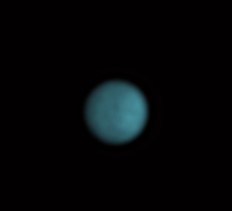
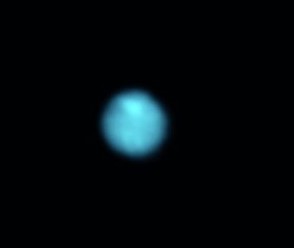
On 1 January 1801, Giuseppe Piazzi at Palermo Astronomical Observatory in Sicily, discovered a new “wandering star”, he called it Ceres and announced the new planet to the world. It would have stayed that way if not for the discovery of 2 Pallas, 3 Juno and 4 Vesta in a short periof of time and orbiting the Sun at almost the same distance as Ceres.
Nothing really changed until 1845 when Henke found 5 Astraea (named by Carl Friedrich Gauss) when he was looking for 4 Vesta, by the end of 1851 astronomers had discoverd a further 15 of these bodies which were not comets, but did not appear to be planets either. A debate had been taking place for several decades following the discoveries of the first 4 objects, at some point the word Asteroid was coined, from the Greek meaning “starlike in appearance”, and at some point, all minor solar systems bodies, that were not comets or Moons, were called asteroids.
As technology has improved, from the early 1990’s, researchers started to discover bodies in the outer solar system that appeared to resemble Pluto in both physical characteristics and orbital motion, implying they may have common origins. This region, beyond Neptune, is called the Kuiper belt and the Scattered disk.
The Kuiper belt is a relatively thick region of space that resembles a doughnut, it extends from approximately 30 to 50 AU comprising two main populations of Kuiper Belt Objects (KBOs) there is the classical Kuiper-belt objects, often referred to as cubewanos, these seem to all lie in orbits untouched by Neptune, then there is the resonant Kuiper-belt objects, these are bodies which Neptune has locked into a precise orbital ratio. Those with a 2:3 orbit the Sun twice for every three complete Neptune orbits and the 1:2 where the object goes around once for every two complete Neptune orbits.
These ratios, known as orbital resonance, allow both groups of KBOs to persist in regions where Neptune’s imposing gravitational influence would otherwise have scatered object over the age of the Solar System, thus removing them and clearing the space, but these persist because the objects are never close enough to Neptune to be scattered by its gravity. Because Pluto is now known to be the largest member of the 2:3 resonance group, those in 2:3 resonance orbits are referred to as “plutinos”, however, those in 1:2 resonances are known as “twotinos”.
Those in the scattered disk popul;ation are, in contrast to those in both Kuiper belt populations, disturbed by gravitational influence from Neptune. All Scattered-disc objects are known to come within gravitational range of Neptune at their closest approaches, which allows Neptune to interfere with the orbits over extended periods of time. Ongoing research suggests that the centaurs, a class of icy planetoids that orbit between Jupiter and Neptune, may simply be SDOs thrown into the inner reaches of the Solar System by Neptune, making them “cis-Neptunian” rather than trans-Neptunian scattered objects. Some objects, like (29981) 1999 TD10, blur the distinction, the Minor Planet Center (MPC), which officially catalogues all solar system objects that are not confirmed planets, now lists Centaurs with scattered dick objects (SDOs).
Astronomers started to wonder how many bodies were in the outer solar system, where any actually planets? this debate hit a peak with the discovery of Eris (minor-planet designation 136199 Eris) by Mike Brown and his team at the Palomar Observatory in 2005. Initially it was thought that this scattered disk object was larger than Pluto, which caused one hell of a stir with the media, public and astronomical community. Named for the Greco–Roman goddess of strife and discord, the object soon started to live up to it’s name.
Some inital estimates suggested Eris was up to 3000km in diameter, significantly larger that the estimates for Pluto at that time – estimate for Pluto varied from as little as 2000km to as high as 2800km. However, as time went by new, more accurate data came in, and it seemed as if Pluto and Eris were virtually the same size. More accurate estimates for Pluto had narrowed it down to around 2400km, and light curve data from Eris was giving a similar figure.
There were several measurements over the years, in 2005, the Hubble Space Telescope was used and researchers estimated it to have a radius of 1,999KM (3,998km diameter), then in 2007, Spitzer was used to give an estimate of 1,300km (2,600km diameter) and it sort of sat there.
Now we jump to November 2010, Eris became the target of one of the most distant stellar occultations yet attempted from Earth. The preliminary data from this experiment cast doubt on all previous size estimates, the teams announded there results nearly a year later in october 2011, they had estimated Eris to have a diameter of 2326±12 km, this makes Eris a little smaller than Pluto by area and diameter, which is 2372±4 km across, although Eris is more massive. It also indicates a geometric albedo of 0.96. It is speculated that the high albedo is due to the surface ices being replenished because of temperature fluctuations as Eris’s eccentric orbit takes it closer and farther from the Sun.
Back in 2005, the adaptive optics that had been fitted to the Keck Telescope had been used on Eris, and the team involved found Eris had a moon, later named Dysnomia – this was a bonus, it allowed researchers to calculate the orbit and then work out the mass of both Eris and Dysnomia – the result was astounding. Eris was found to be 27% more massive that Pluto despite being a smaller volume, and was around 0.28% the mass of Earth – this made Eris the 9th most massive object that was orbiting the Sun!
The IAU gets Involved
The IAU state thast a draft proposal for the definition of a planet was debated vigorously by astronomers at the 2006 IAU General Assembly, however, only around 4% of the membership actually took part in the debate as many had left the conference by the time this was discussed. However, in the debate that did occur a new vision of the definition of planet took shape.
This new vision was more acceptable to the majority of those that were present for the debate and this was then presented to the remaining members of the IAU for a vote at the Closing Ceremony of the General Assembly. Clearly a solution was required as there was considerable confusion amongst the public, media and scientific community, so by the end of the Prague General Assembly, the IAU members present voted on the draft resolution and this further definitioned a planet in the Solar System would be as follows:
It is a celestial body that
(a) is in orbit around the Sun,
(b) has sufficient mass for its self-gravity to overcome rigid body forces so that it assumes a hydrostatic equilibrium (nearly round) shape, and
(c) has cleared the neighbourhood around its orbit.
This seems, on the surface, to not be overtly controversial, but all decisions have unintended or unrealised consequences, and this threw a big spanner in the works, and not just in the eyes of the public and the media – the scientific community, especially planetary scientists, who a cardre of objected quite vocally to the last classification (c) as this has conseuences that really did cause problems.
All the proposed planets that existed then, Pluto, Ceres, Eris, Makemake and Huamea, all met the first two definitions in that
- they orbit the Sun, not another body, and
- they all have sufficient mass that gravitations forces have resulted in hydrostatic equilibrium and thus they are spherical – or at least oblate spheroids as most “spherical” bodies actually are – Huamea more so that any other body for reasons still not fully understood.
Then we have the logjam that became the problem – all of these bodies are in either a gravitational resonance with Neptune, or they are part of the Scattered Disk family – the exception being Ceres which orbits deep within the main asteroid belt between Mars and Jupiter, however, the one thing all had in common was that the orbits they have are not clear of other bodies (excluding moons). This seemed an arbitrary definition to many, and many still see it that way because that definition is very wooly – none of the accepted major planets have truly cleared orbits, yes they have gravitational influence over the space around them that stops other objects joining them, in theory, in that orbit, but this is not really true either.
Earth is now know to have psuedo moons, smaller solar ystems bodies that get caught in the gravity of the Earth-Moon system and will orbit the pair for months to years before being ejected, or they could even impact the atmosphere or even the surface, there are asteroids in the inner solar system that mirror earth’s orbit around the Sun, Venus has been found to have similar minor bodies behaving the same way, Jupiter has tens of thousands of objects that are orbiting the Sun, trapped in the Lagrange L4 and L5 points, 60° ahead of Jupiter and 60° following in the orbit – these are trapped by Jupiter’s gravity, but some will escape via gravitational forces and interactions amongst themselves – so the definition of “cleared it’s orbit of other bodies” needs to be more clearly defined – yes, this is being picky and splitting hairs – but clarity of communication in science is vitally important.
Anyway, regardless of your take on this, the unintended, or intended consequences of David Levy and a cohort of astronomers, was that Pluto, Ceres, Eris, Makemake and Huamea all failed in the last definition, thus they were no longer considered planets – but neither were they asteroids as clearly they were nothing like an asteroid – in the case of Pluto, it had a confirmed atmosphere, something no asteroid in believed to be capable of – shock horrow – if they are neither planet nor asteroid – what are they?
Well, they decided that if these smaller bodies do meet all the criteria for planethoood, but they were not asteroids, they needed a name – that chosen was Dwarf Planet, this differentiated them from both planets and asteroids – so instantly, the solar system went from 9 major planets and other bodies to having 8 major planets, 5 confirmed Dwarf Planets, and the tens of thousands of asteroids catalogues by the MPC in cambridge Mass.
Pluto is demoted – but get a mission all to itself.
That is how and why Pluto lost its status as a planet and is now classified as a dwarf planet. It failed the final item on the checklist – other icy Kuiper belt bodies are within its orbital path. The decision, a controversial one to many for sure, is debated by scientists, the media and the public to this day. This is an ongoing debate with valid arguments on both sides of the aisles – and we will not delve deeper into that debate here.

Credits: NASA
Ceres gets a promotion – but has to share a mission with 2 Vesta
At the same time Pluto lost it’s major planet crown, Ceres was promoted. Ceres, on a definition roller coaster since it’s discovery in 1801, initially considered a planet, then reclassified as an asteroid, suddenly, with the raising of hands, was elevated to dwarf planet status.
The Inner solar system family suddenly expanded, it may have lost an asteroid, but it gained a dwarf planet – good for Ceres, but not for Pluto according to many.
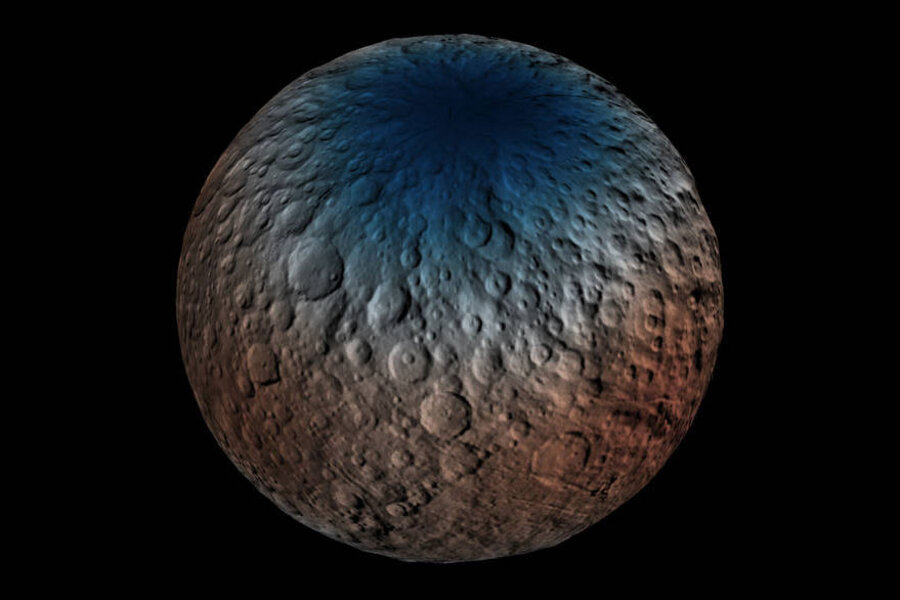
Credit: T.H. Prettyman & N. Yamashita/Planetary Science Institute
What are the dwarf planets?
Many people ask what the difference is between a major Planet and a dwarf planet, frankly, little is known about any of them with the exception of Ceres, which was visited by the Dawn spacecraft in 2015, after it had previously orbited and fed back information about Vesta – what was now the largest asteroid but the 2nd largest body in the main Asteroid belt, after Ceres itself.
Ceres is tiny compared to even the smallest of the planets – the smallest major planet is Mercury (4,879km), which is nearer the size of the Moon, but about 20 times less massive than Earth – however, Ceres (964.4km) is some 625,000 times less massive than Earth and around 1/5th the diameter of Mercury (4,879km) – Ceres is tiny.
Pluto (2,372km) and Eris (2,326km), the largest of the dwarf planets discovered to date, are 18.59% and 18.23% the diameter of the Earth (12,756km), respectively, and about 7500 times less massive, interestingly, they are still significantly more massive that Ceres.
But size alone tells us very little, we know there are stars that range in size from that of Saturn (EBLM J0555-57Ab) to stars as large as the Orbit of Saturn (Stephenson 2 DFK 1).
To see how the Dwarf planets compare to the Major planets, we need to look at how they are made – the actual chemical composition would be a red herring because the chemical constituents of all the major planets vary, but where the difference comes is inside them and their mass.
It should be remembered that a body, made up primarilly of water ice, can be as small as 250km in diameter to achieve hydrostatic equilibrium and become spherical, I think we would all agree an object this small and made up almost exclusively of water ice hardly constitutes a planet, at the other end, a body made up primarilly of rocks and metals would need to be in excess of 750km across to achive a spherical shape.
So, lets look at the confirmed Dwarf Planets. In this image we can see the eight largest Trans-Neptunian Objects, including Pluto and Eris, in comparison the both the Earth and our Moon – this scaled artists impression gives a clear view of the small size of all confirmed Dwarf Planets

It is believed the Ceres, although smaller than Pluto and Eris, has a similar internal structure, based on data from the Dawn mission, it is now believed that the internal structure of the larger dwarf planets is somewhat like this artists impressions below. However, when compared to the Moon, on the right, there is a marked difference in how the body is differentiated
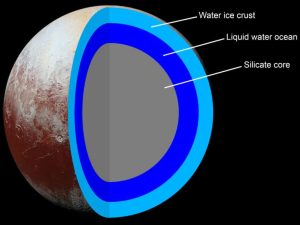
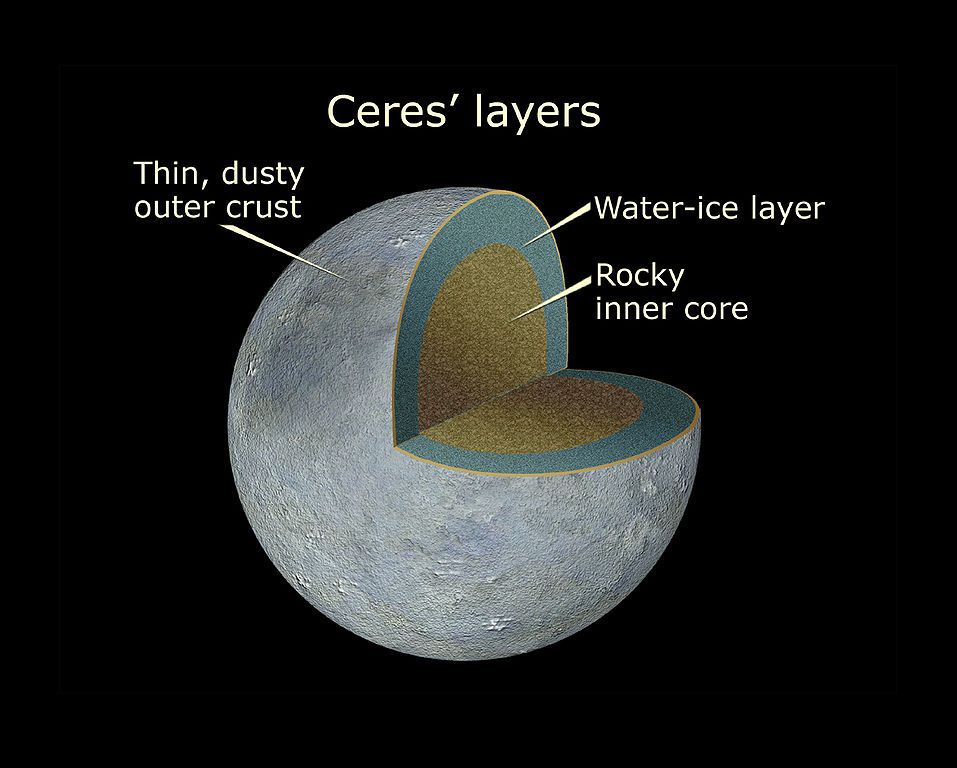

Now lets look at the internal structure of the Inner solar systems planets,


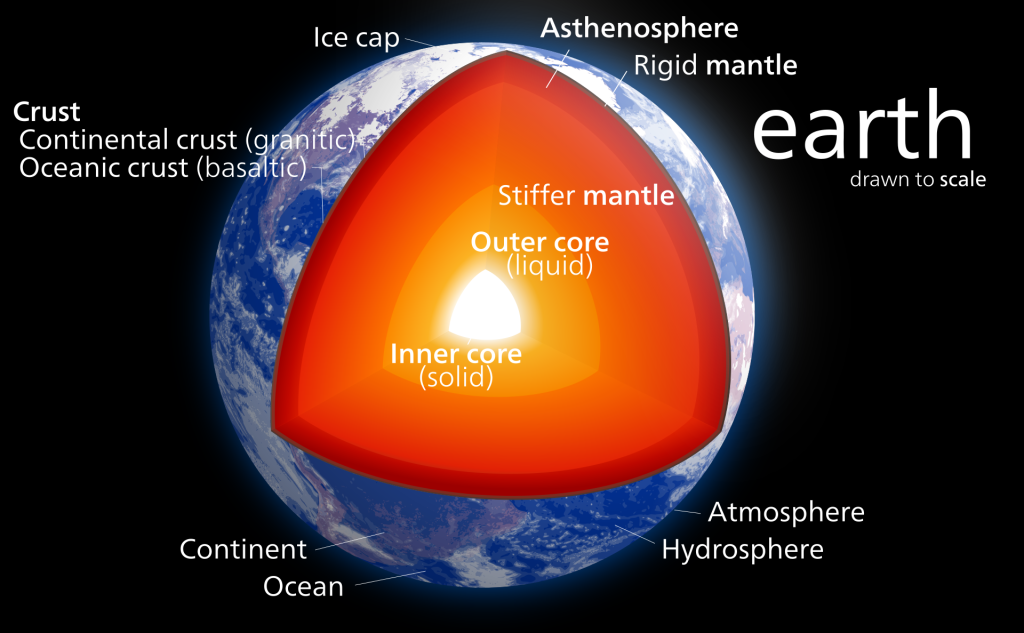
It is clear, looking at these artists impressions based on actual data, that there is a clear dividing line between the dwarf planets and the major terrestrial planets, even the Moon has a structure more reminiscent of the major planets and is larger than Mercury – where it not in orbit with Earth it would be classified as a major planet, however, even the largest of the discovered Dwarf Planets does not resemble the Moon, is only 18% the mass and around 1/5th the diameter.
I understand that people were pationate about the reclassification of Pluto as a Dwarf planet, but for it to remain a planet would result in even more confusion, especially amongst the public who may not be as clear on what a planet is or is not as they mostly rely on the media for their information – and we all know how inaccurate some is.
I do not wholly agree with how the IAU handled the situation, because they stated that anything not orbiting the Sun cannot be a planet by implication – that presents a problem for Exoplanets, which by the definitions given, are planets if you ignore the comment about the Sun. A more accurate definition would be;
(a) is in orbit around Brown dwarf , star or stellar remnant,
(b) has sufficient mass for its self-gravity to overcome rigid body forces so that it assumes a hydrostatic equilibrium (nearly round) shape, and
(c) has a diameter no less than 3000km and/or
(d) a mass at least equal to 7.2×1022 kg
Any object that falls below the values of (c) & (d) should be classified as a Dwarf Planet, but even these need to have a range of definitions as it is clear that within the Dwarf Planet family there is a range of compositions and masses, some seem to be primarily made up of Ices with a small amount of metals and silicates, whereas others seen to be dominated by a metal and silicate makeup – this will impact how they differentiate inside and will impact their evolution and their volume.
However, getting too deep into that debate is not for this article, but we need to look at other bodies in the solar system that would be classified as either a Dwarf Planet or a Planet were it not orbiting a major planet.
If we look at the Moons of the Solar system, we have a large number of “Dwarf planet mass” and even “planet mass” objects that are orbiting the major planets
Spherical Moons in the Solar System
| Body | Diameter (KM) | Mass (kg) | Mass ratio. Moon =1 | Percentage of Lunar Mass | Object type if orbiting the Sun | Atmosphere? |
|---|---|---|---|---|---|---|
| Moon | 3474.2 | 7.35E+22 | 1.00000 | 100.00% | Planet | Ar, He, Na,K,H |
| Io | 3630 | 8.94E+22 | 1.21671 | 121.67% | Planet | SO2 |
| Europa | 3138 | 4.80E+22 | 0.65327 | 65.33% | Dwarf | O2 |
| Ganymede | 5268.2 | 1.48E+23 | 2.01682 | 201.68% | Planet | O2 |
| Callisto | 4820.6 | 1.08E+23 | 1.46413 | 146.41% | Planet | O2, CO2 |
| Mimas | 396.6 | 3.75E+19 | 0.00051 | 0.05% | Dwarf | |
| Enceledus | 504.2 | 1.08E+20 | 0.00147 | 0.15% | Dwarf | H2O, N2, CO2, CH4 |
| Tethys | 1066 | 6.17E+20 | 0.00840 | 0.84% | Dwarf | |
| Dione | 1123.4 | 1.10E+21 | 0.01490 | 1.49% | Dwarf | |
| Rhea | 1528.6 | 2.31E+21 | 0.03138 | 3.14% | Dwarf | |
| Titan | 5152 | 1.35E+23 | 1.83078 | 183.08% | Planet | N2, CH4 |
| Iapetus | 1471.2 | 1.81E+21 | 0.02457 | 2.46% | Dwarf | |
| Miranda | 471.6 | 6.59E+19 | 0.00090 | 0.09% | Dwarf | |
| Ariel | 1157.8 | 1.35E+21 | 0.01837 | 1.84% | Dwarf | |
| Umbriel | 1169.4 | 1.20E+21 | 0.01633 | 1.63% | Dwarf | |
| Titania | 1577.8 | 3.50E+21 | 0.04763 | 4.76% | Dwarf | |
| Oberon | 1522.8 | 3.01E+21 | 0.04102 | 4.10% | Dwarf | |
| Triton | 2706.8 | 2.14E+22 | 0.29125 | 29.12% | Dwarf | N2, CH4 |
| Charon | 1207 | 1.52E+21 | 0.02069 | 2.07% | Dwarf | |
| Dysnomia | 700 | 4.00E+20 | 0.00544 | 0.54% | Dwarf |
Whilst most of the sphericalised Moons in the solar system would be classified as Dwarf Planets were they to be orbiting the Sun and not another solar system body, there are 5 that would be classified as planets in their own right, these are The Moon, Callisto, Ganymede, Io and mighty Titan
Could life exist at a dwarf planet?
My personal feeling is the answer is no –
HOWEVER, we do not know enough about how life gets started and how abundant it truly is. The compossion of Ceres is such that as all the chemicals needed for life seem to be present at the surface, thus it is highly likely they are dissolved in the brine Ocean that sits a few teans of miles beneath the crust, clearly heated by the core which has some form of power source to have remained heating the ocean over the life of the solar system – research data fom the Dawn mission and put into a program used to model larger planets has indicated that Ceres may have started off cold, as it’s low mass did not allow for heating caused by impacts, but radiological heating in the core, likely from Uranium and Thorium resulting in the core warming to the point where the little world started to undergo differentiation and underwent geological activity. It appears there is still heat in the core that keeps the ocean warm – although it is unlikely, we cannot rule life out unless or until we can get probes into the ocean and test the waters for signs of biological activity.
Observation by New Horizons, as it flew passed Pluto at more than 15km/s, dicovered evidence of geological processes, there was surprises galore at the diminutive body, not least of which is that there is clear evidence for a subsurface brine filled ocean more than 100 miles (161 kilometers) below Pluto’s surface, we also found hydrocarbons and other materiasl that life needs as far as we know – could life exist in the Ocean of this diminutive world?
Organic molecules, in abundance everywhere in our solar system, have been found on Ceres and Pluto and there is some evidence for them on Eris, Orcus and other Kuiper Belt and Scattered disk objects.
But the one missing ingredient for all the dwarf planets appears to be a source of energy, the specualtion that Ceres has a warm core means that other, larger, dwarf planets may also have warm cores, but is that energy sufficient to power the creation and evolution of life?
Sunlight doesn’t work out beyond Jupiter, bodies out here are simply too far away from the Sun for solar energy to have sufficient energy to significantly heat any body, especially at the distance of the Kuiper Belt and the Scattered Disk, these bodies are at least 2.7 billion miles (4.4 billion km), the Sun is just the brightest star in the sky – at Pluto, the Sun has about 1000 times less energy that at Earth, at the upper atmosphere the Sun heats supplies an average of around 1.35kW/m², but at Pluto, that energy drops to around 1W/m², and as Pluto is a much smaller target that Earth, the heat is gets from the distant Sun is about 1/10,000 that Earth recieves, the problem being extenuated by Pluto’s thin atmosphere which cannot act as a blanket.
Amazingly thow, scientists have discovered life on Earth in what we would consider as the most hostile of environments imaginable – we have found life in alkaline pools that strip flesh from other creaches, acidic pools too toxic to enter, life found more than 10 miles beneath the surface of the planet in rocks, complex life at the bottom of crushing oceans depths and even inside an active volcanoes, more intriguing though for me, life in the lakes under miles of ice for millions of years in frigid Antarctica – reminiscent of Enceledous, Mimas and Europa.
When it comes to where we will find life, as far as I am concerned, all bets are off – with the except of stars!!